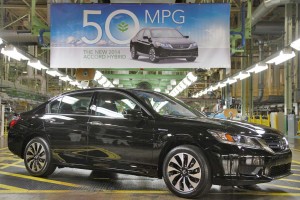When is an “import” not an import? That’s no longer a rhetorical question, suggests Honda Motor Co. which says it is now exporting more vehicles from the U.S. than it is importing.
Its U.S. subsidiary American Honda exported 108,705 vehicles to 50 countries outside North American last year while importing just 88,537 vehicles from Japan. With the midsize Accord leading the way, Honda has increased the export of American-made vehicles nearly six-fold since 2009 while reducing imports by more than 50% over the same period. The value of those exports reached $2.66 billion last year.
“This is really a significant milestone for our North American operations, and one that’s been 30 years in the making,” said Honda Senior Vice President Rick Schostek, making reference to the launch of Honda’s first U.S. assembly plant, in Marysville, Ohio, three decades ago.
Honda claims it is the first foreign-owned maker to be exporting more vehicles than it imports, a figure that could not immediately be verified as other makers are tallying up their own statistics for 2013. But there has been a significant push across the auto industry to export more products from U.S. assembly plants in recent years. That includes not only Asian but European and Detroit-based makers, as well.
(Honda and other “imports” are rapidly expanding U.S. production. Click Here for the full story.)
Nissan, for example, expected to ship 14% of the vehicles it produced here abroad in 2013, up from 12% the year before. And it recently announced plans to double the number of export markets served by 2015. Mercedes-Benz, meanwhile, uses its factory near Tuscaloosa, Alabama as the sole global source for its M-Class sport-utility vehicle.
The trend reflects several industry-wide trends. In some cases, manufacturers are finding it easier to produce specialized models in one plant for worldwide distribution. In other instances, makers like Honda are trying to build mainstream products closer to the key markets where they’re being sold.
(Jeep sets a global sales record. Click Here for more.)
The weak dollar has made U.S. manufacturing more competitive, meanwhile, even as the rise in quality of American-made vehicles has made them more acceptable to consumer around the world, analysts suggest.
As recently as 2009, Honda’s U.S. assembly plants produced a total of just 19,976 vehicles for export. By 2013, that rose to 108,705. During the same period, the maker’s imports dipped from 186,640 to just 88,537.
At this point, the Japanese-based maker claims that 95% of the vehicles sold in the U.S. under the Honda and Acura badges are being assembled somewhere in North America. That is, in fact, the asterisk on the import numbers, as Honda doesn’t count vehicles made in Canada or Mexico. In fact, it is getting ready to start producing the all-new Honda Fit subcompact – which debuted at the North American International Auto Show in Detroit earlier this month – at a new Mexican factory.
(Ford claims Focus is world’s best-selling nameplate – but Toyota isn’t so sure. Click Hereto see why the makers disagree.)
To date, the Accord has been the most popular export model, through the end of 2013 totaling 466,695 vehicles. The smaller Civic followed close behind at 439,331. Other key export models include the Honda CR-V crossover and Odyssey minivan, while Honda is increasing export production of two Acura crossovers, the RDX and bigger MDX.
Honda’s Schostek noted that not only is the maker increasing exports of U.S.-made vehicles but also of American-made engines, transmissions and other components used in assembly plants in other parts of the world. That’s become big business for the factory in Anna, Ohio that is now Honda’s biggest engine plant anywhere in the world.
And to back up the shift in production Honda has been rapidly expanding the design, research and development capabilities of its U.S. operations. A third of the vehicles being built in the States were developed here, noted Schostek during a conference call, while U.S. designers and engineers helped “co-develop” another third.
“Our goal,” he added, “has been self-reliance in North America.”

